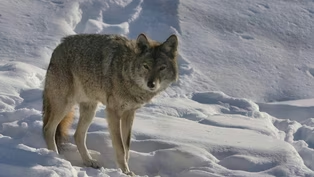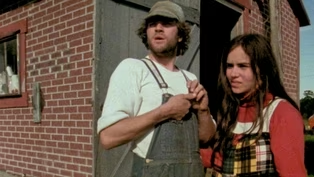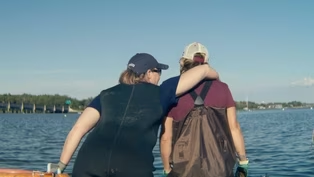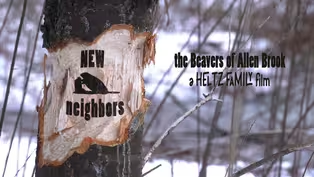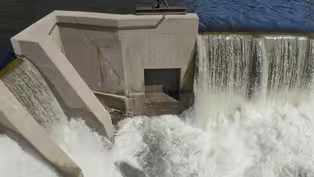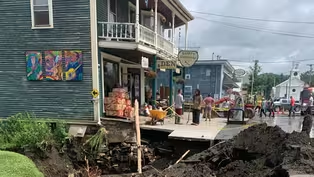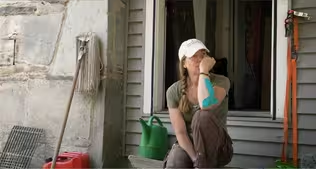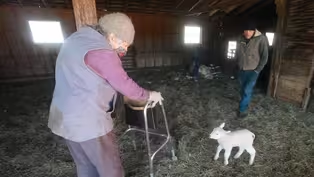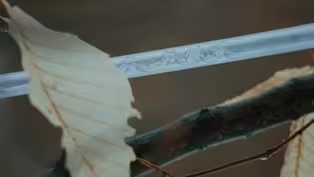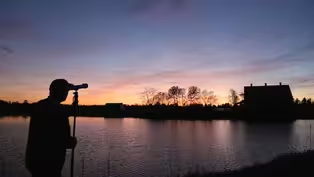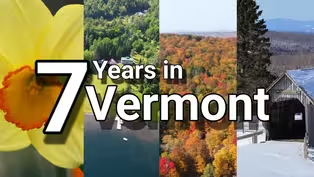Made Here
Ciderology Vermont Hard Pressed
Season 14 Episode 2 | 56m 54sVideo has Closed Captions
History of cider in Vermont, the evolution, the current industry, and the future.
This Vermont-based documentary delves into the history of cider in Vermont, the evolution, the current industry, and then looks at the future.
Problems playing video? | Closed Captioning Feedback
Problems playing video? | Closed Captioning Feedback
Made Here is a local public television program presented by Vermont Public
Sponsored in part by the John M. Bissell Foundation, Inc. and the Vermont Arts Council| Learn about the Made Here Fund
Made Here
Ciderology Vermont Hard Pressed
Season 14 Episode 2 | 56m 54sVideo has Closed Captions
This Vermont-based documentary delves into the history of cider in Vermont, the evolution, the current industry, and then looks at the future.
Problems playing video? | Closed Captioning Feedback
How to Watch Made Here
Made Here is available to stream on pbs.org and the free PBS App, available on iPhone, Apple TV, Android TV, Android smartphones, Amazon Fire TV, Amazon Fire Tablet, Roku, Samsung Smart TV, and Vizio.
Providing Support for PBS.org
Learn Moreabout PBS online sponsorshipMore from This Collection
Explore the natural word and environment of our region.
Video has Closed Captions
Investigating the eastern coyote hunting controversy in Vermont. (38m 6s)
Vermont People: Peter and Jane Flint
Video has Closed Captions
A young couple in Wolcott, Vermont in their first year running a small dairy farm. (1h 48m 5s)
Video has Closed Captions
In New Hampshire’s small fishing and aquaculture industries, women have broken down barriers. (45m 31s)
Video has Closed Captions
Teenagers spend a week making friends, rock climbing, and pondering the future in New Hampshire (35m 49s)
New Neighbors: The Beavers of Allen Brook
Video has Closed Captions
A Vermont homeowner sets out to learn about his new neighbors, the beavers. (29m 37s)
Video has Closed Captions
The story of a New England entrepreneur rehabilitating old dams to produce clean energy. (27m 42s)
Harry's - One Vermont Community and the Flood of 2023
Video has Closed Captions
Harry's Hardware in Cabot, Vermont and the flood of July 2023. (19m 45s)
Video has Closed Captions
A story of the July 2023 Vermont floods that devastated a street but not the community spirit. (37m 21s)
Video has Closed Captions
Octogenarian sheep farmer Bambi Freeman faces a difficult life transition. (15m 13s)
A look at maple syrup practices as part of Quebec culture, transmitted and adapted with time. (14m 52s)
Defending The Dark - Preserving the night sky in Maine
Video has Closed Captions
How saving the dark sky can reduce the harmful effects of light pollution. (28m 53s)
7 Years in Vermont | How the changing seasons affect a Latin American Vermonter
Video has Closed Captions
A Nicaraguan's perspective on seven years living in Cabot and the changing seasons (23m 1s)
Providing Support for PBS.org
Learn Moreabout PBS online sponsorship>> Hi I'm Eric Ford.
Back with another look at the fantastic local beverage industry with ciderology, Vermont hard pressed.
You may have seen his other films focused on the Vermont IPA and Vermont distilleri distilleries.
He looks at the evolution, the current industry and the future.
You can watch ciderology and other stories about the region streaming on Vermont PBS.org and through the PBS app.
Enjoy the film and thanks for watching.
[ Music playing ] [ Music playing ] >> The Hhistory of cider is different than beer or spirits because it was right from the get-go an imported food source.
You didn't drink the water in colonial times and earlier due to the nature of different bacteria and issues in the cleanliness of the water and cider was always a guaranteed safe beverage, even if it slightly turned.
There was nothing toxic to it that ever was a main issue.
Apples and hard cider just become second nature.
And in New England, one of the biggest prized apples was the Baldwin apple that originated in Massachusetts, I think about 1720s or there abouts and it was a unique apple that was discovered and became one of the most prized to make cider.
Cider itself both historically and although there's very good historical varieties, although you had the sweetness and it did have all the aspects rather than having to blend but Baldwin was one of the more prized than the Roxbury Russet and these apples are all across New England so it was kind of a food source right from the get-go and references in New England started off.
Samuel who was best known for the Salem witch judge for the witch trials kept a very detailed diary of his travels and you have to understand that in the late 1600s, the courtrooms will actually cleared out taverns and other places and he had a disdain for some of the ales and hard spirits but cider was considered the every day beverage.
By the 1770s, cider is everywhere across New England and New York and further south and was a prized commodity.
Once against, it was tough that kept you going through the winter.
It was part hydration, particle RIs and also had nutrients in it that were very valued.
We get at a point in Vermont where right at 1790 where the first brewery is starting to launch you already see widespread cider documents.
One reference that I've always loved, we talked about how the average family of four was going to put down between 30 to 40 barrels of cider in the basement to get through the winter.
You also have references in early Vermont during those about how you kept your best barrel or two of hard cider set aside for when the local priest would be coming to visit the home.
In the apple season in Vermont it's depending on if it's early or late season apple could be the middle of August all the way through the end of October and even so, one of the things that did occur in Vermont that there are some references I found over the years is letting the frozen apples be the last of the harvest where they would harvest the frozen apples and run them through the press where they kind of dried and shrivelled up making a more concentrated hard cider or an iced cider as it's sometimes referred to.
And cider is really everywhere and nowhere at all in Vermont and we have the onset of prohibition at a local level in the 1820s and 30s.
Once prohibition came in there's a massive decline in the orchards.
In Vermont specifically, you have cases where orchards were cut down by the 1809s and early 1900s just to stop cider production all together.
And once we go through federal prohibition which is 1918 to 1932 it's really a lost art of cider production.
Prohibition took away the interest.
Apples return to this wholesome food rather than being crushed, pressed and fermented into a beverage.
We basically don't have hard cider on a commercial level in Vermont until after craft breweries are already open.
And we have a -- in 1991, the Woodchuck's hard cider was first produced, I believe that's where it first started as a side project of a winery and it gained traction.
Hard cider was of much more difficult sell in not only Vermont but New England and woodChuck ultimately through different iterations is now this very large facility in Middlebury, Vermont.
>> Cider making is an old and a wonderful trade.
It goes back thousands of years, really.
The process is quite simple.
You need juice, apple juice and you need yeast to ferment the sugars and the juice into alcohol and it can happen all by itself using wild yeast that grow naturally in nature.
So at home, you can squash up your apple and put them in a bucket and wait two or three weeks and over time that turns to hard cider.
The danger with that is you're not controlling the fermentation.
You may try to taste it afterwards and it tastes funny so there's a lot of things that can go wrong with the basic natural process so a cider maker's job is to take the same juice that you started with and try to Taylor or control the fermentation to get a consistent and desired outcome every time.
>> It started in 1991.
It was a small little cidery in Proctorsville, Vermont.
They had a wine company.
They started seeing ciders from Europe come into the U.S. and they thought they could make one that could work for the American palate.
So that has grown to what it is today.
And throughout time we kept adding different signs.
The brand grew and we started seeing them come through the ski slopes in Vermont and we started reaching outside of Vermont and growing that way.
The company grew too big.
In 91 when it started it was in a two-car garage.
Very small on a 10 ounce sew Darr filler and we fill the last two ounces of every bottle by hand and it really outgrew that fast.
So in '96 we moved to springfield Vermont and we had some other investors that came in and out of it.
When it moved to 96 they were investment in it and then, in 98, they became part of it and they had an investment in it and in 2000, springfield and moved to middlebury Vermont down the road from where we are today and we were there from 2000 to 2014 when we opened this one.
>> It's our first cidery that we built and dedicated to the woodChuck brand.
You heard stories about how we grew from the first two car garage to the first rented space in a brewery to a leased space here but fortunately for about six years ago now we decided we needed a home of our own and they decided to develop this site here in middlebury.
It was our hometown and we wanted to cidery that could really produce it the way we wanted it to be produced.
>> Back in the early 90s it was a sweeter palate than in New York so a lot of the European ciders were much Drier where the American palate was used to the apple juice and sodas and juices on the market.
They range greatly now from sweet to dry to fruity which you just didn't see.
>> Cider is it's own thing.
It's made more like wine and it's packaged more like beer.
So we couldn't just roll into a winery and have it suit our needs nor could we just go into another brewery and have it suit our needs.
Cider is fermented like a wine.
Specifically like a white wine instead of grape juice we're using apple juice to make our base cider or an apple wine and so all of our tanks are temperature controlled stainless steel tanks and they're designed to keep that cider at a comfortable room temperature.
They don't want to be too cold.
They'll stall out and they don't want to be too hot or else they can die and produce some so you want to keep the yeast nice and comfortable at a cool fermentation.
For us, that's around room temperature of 65 to 70 degrees.
So that's how they're designed.
After that, cider is different.
Where as in the wine world you would maybe hold on to your wine for nine months, up to 2 years before you released it for an ageing and settling process.
Cider is ready to be drunk soon after it is produced so we want to turn around the tanks more frequently.
So when we walk around and look at the seller, you can see a lot of extra smaller stainless steel tanks for the blending and holding process.
Once the fermentation is complete, we move the cider over to a base holding tank and it doesn't need to age or settle out overtime like the wine.
What we do is filter it and then we can blend it with whatever ingredients we are adding to the cider for whatever style or flavoured cider it's going to be then there's the production side.
We're not producing it in large wine bottles like the winery.
It's more packaged like beer.
So we're going into the traditional beer packages.
Single serving cans or bottles so our production facility may look like a brewery that you have been to where we're putting cider into single serve packaging.
That's what they want.
They want to be able to buy a six pack or 12 pack of cider and enjoy it during all the occasions they would normally be DRIJing the beer.
Our bottling line moves at about 600 bottles a minute and it takes ten hours to produce them.
Our line is relatively newer and produces 100 cans a minute so it takes ten hours to produce 2,000.
So they may look at us and think we're quite huge but on the scale of things we're bigger than a lot of small beverage companies.
The woodChuck amber is the same recipe that we started with 30 years ago.
>> Quality control comes from consistency and that has to do with sourcing a particular mix of apples and fermenting them in a way.
For amber it's a fresh, sweet apple cider so we're using the American varieties, the table varieties of apple for that cider.
Red delicious, macintosh, granny Smith, the things that are readily available.
That became the base cider for something like amber.
The fermentation is what makes it consistent.
Batch after batch and the final blending and packaging is there.
>> At the end of the day, this is where our heart is.
This is where our focus is and it's exciting that we have this cider here to help out us and the industry.
>> Our primary supplier, they're right down the road in Cornwall and they're one of the larger orchardists in the state.
One of the larger orchards in the state.
So we worked with them over a number of years on trying to see if they can work together to get more cider apples growing here in the state to meet the demand of the cideries in Vermont so that we can buy more and more of our apples within the state and not having to rely on juice from the northeast and farther away places.
>> My father is from Virginia.
My mother was from Connecticut and they met in New York City in the 60s and my dad was always sort of planning on going in the apple business.
So they landed in Vermont and purchased a dairy farm on it's way out and converted it to apples.
They never intended to be dairy farmers.
Only apples.
>> So our farm has been a wholesale farm since it's conception in 1974 and we packed -- we grow, pack, store, and ship not in that order and so we have always had a need for an outlet for lower grade fruit other than the fresh eating apple varietis.
So we have a keen focus to quality regardless of whether it's a cider apple or a fresh eating apple and over the years, our relationship has always been very strong and by cideries, original that was sweet cider.
Tweet drinking cider.
And around 2012, 2013, there was a real shift in demand for Vermont apples to supply hard cider companies and fortunately, Middlebury has an established cidery in woodChuck hard cider has been here for a long time and we -- our relationship with them has grown and built.
A vast majority of our harvest workers, the people that pick the apples are from gentJamaica.
They haven coming to sunrise orchards -- I think our gentleman that's been here the longest has been here since 1985.
There's probably four or five of the guys.
Right now we have 18 workers here.
And all of them have been coming here ten years.
So every year they come up from Jamaica through the H2A program and a wholesale apple farm without those workers.
They contribute to the economy and they spend their money here and we are grateful that they are willing to travel so for a relatively short window of time.
The hard cider industry is very competitive.
And ultimately the cost of supply, in my experience, in the last -- as the industry has sort of settled in the cost of supply becomes the most critical in terms of production and it's been interesting to see higher quality for them which would mean better yield, better flavour profiles, yield, that those things could carry over into a higher value for us.
And ultimately the downward pressure for these companies to be competitive may cause the bump in price that definitely happened for the last five years brings the value.
We have been getting some of the highest prices for cider apples as a result of great relationships with folks.
Hopefully it will continue.
>> So the apple program and the fruit program and also do work with grapes.
Conduct research.
So we conduct a number of different research projects.
Usually almost always grower driven.
We try to answer the question.
We do applied research, we do teaching so we teach a Viticulture, grape production and orchard management class here at the farm and we provide outreach.
So I provide the outreach to the grower community in Vermont and surrounding regions when they have questions, mostly about pest management, crop management, as well as a little bit on cider management.
Vermont is a perfect place to grow apples.
And our apples are actually ferel.
We have the perfect climate and Moisture and soil type.
They're very adaptable but because we're in this moist, especially, you know, fairly humid area with rain fall, and it's cold but not ridiculously cold, we have certain challenges that there might be less of in other parts of the country.
So some of the biggest issues we have in Vermont are disease problems because of the Moisture and diseases.
We have a whole host of insects that all want to eat your apples and that makes it more difficult to grow apples here than on the west coast or on the dry side of the west coast.
I should say inside the mountains where it's high desert.
As long as you can bring water to the fruit, you don't have the humidity.
So we have challenges even though these trees really want to grow here.
You look around the road sides, there's trees everywhere.
And to navigate the challenges for everything it's going through to help make a commercial crop.
>> When cider became -- started to become an industry again, that cider really was produced from the dessert fruit that everybody was growing on a commercial scale.
So Woodchuck and many of the cideries that came after it to this day are still primarily using what we call dessert fruit, mecMCIntoshd riding the coat tails of the commercial fruit market.
That's where all the apples are.
So a lot of product development continues to be done to make a complex or unique product that stands out among that.
On the side and some people think, you know, primarily, there's a whole other class of apples.
The economics are totally different on them because they can't ride on the coat tails of fruit that are going off to the grocery store for 30, 40, 60 dollars a bushel.
They have to capture all that cost in the cider bottle.
So the economics are very different but they do tend to add a very different flavor and complexity.
Many are European in origin and old European varieties and some of the earlier pioneering cider makers of the second wave and some of them were working during the first wave period were going to Europe to find their havevariet Some people say we have apples all over the place.
Maybe we should look at these and see if they have that same kind of complexity.
There's been some of that done.
There's some cideries working on it.
The trick is to scale up from that one tree to the number of fruit that it takes to be commercially viable, at least on a larger scale, but there's been a few that are out there.
They have their lost apple project and they have been selecting and propagating and planting out in orchards and evaluating different varieties and then one from a grower up on the Canadian border, the Franklin cider apple, that one has gotten quite a bit of press mainly because the person discovered it and really took it and ran with it.
So he got a well renowned nationally known nursery that's known for having yellow delicious and red delicious back in the 1800s, they started to collaborate with him to release this variety.
There's now 60 or 70,000 trees out there in the U.S. produced off this.
We're just barely coming around to see some of the fruit baring or some of those trees baring fruit.
And it remains to be seen how that tree performs when it's not the same tree planted in the same location within a stone's throw of the Canadian border.
People think I have this advanced system for testing, it's a really basic system and we measure PH and acidity of all the research projects.
And when Franklin came through, there was a 4th characteristic that we can't measure.
It requires an expensive piece of equipment but it's a pretty simple one number to put on a very complex thing and when Franklin came through I did one sample and it was off the charts.
Really anything I had ever tested.
>> In the beginning I was doing a lot of street cider.
What we were doing is using it as a blend because it had a great dryness to it.
I guess you'd call it.
And it just made a really, really nice blend in our sweet ciders.
People loved it.
And then we started doing hard cider experimenting with it and stuff like that and I was looking at the raw component profiles after an analysis of Terry BradShaw at UBM which told me this was something special.
So we started doing hard ciders with it.
>> It's unique and you can actually patent a plant and I did it because one, I'd like to have a lot of possibilities, especially for the cider industry, in order to really get it out there by patenting it and we have seven nurseries now to license to sell this tree.
It afforded an opportunity for people to access and be able to make a very fine hard cider.
The enter the competition in 2017 and I took a third place bronze in the world competition.
We have a Vice President, if I'm saying that right, of the U.S. cider association and she has brought the Franklin cider and the feedback is excellent.
There's a lot of support right now for the Franklin cider apple.
>> So specialty cider started in the basement of our farmhouse in 2007 when we started producing ice cider.
We had tasted that in Montreal a few months before and we're thinking why is nobody making that in Vermont in a focused way and thought we might just try to do it ourselves.
We did that for a few years and cider started becoming a thing in 2011 and then we realized we had formed relationships with growers with lots of interesting varieties of apples and we could make very interesting dry ciders.
It's a little too big for our farmhouse basement and we moved to this facility.
So we planted 1,000 trees over 2008-2009-20010 it's wholistically managed so there's a group of people in the northeast who help grow apples in a way that really encourages the trees to fend for themselves and the natural environment in the orchard as opposed to killing lots of things to baby sit the trees and we planted 55 varieties, lots of old ones and some European culinary apple varieties and also varieties and it's been a long experiment to figure out which varieties are going to survive in our climate.
And actually produce variety every year with apples that actually taste good in cider.
So out of the 55 at this point there's about 15 that we really like so over the course of the past few years we started top grafting some of the ones that we like.
Some of the ones that we don't like so much.
And pulling some others out.
>> You'll see the increase that this inner stem concept does.
With a metal wire put in before it dries and then you retain these before there's fruiting on a branch to help bring it back into a more horizontal position.
So there's a -- the way hormones flow in a tree depends on angles of the branch and when there's two vertical, they produce a lot of leaf but when you bring them more down to a 60 degree angle they make more flower buds.
>> So it's a pretty unique cider.
It's a dessert wine.
It's a specialty occasion kind of beverage and it goes very well on the dessert menu at a fancy restaurant and so that's where our market was and so that lead us pretty quickly outside of the state of Vermont to additional distribution in places like New York and Boston and D.C. and Chicago.
And so most of the other ciders that we have developed since then have been focused on those customers.
>> Apples are a cryoconcentration of ice Snyder is so different than pressing them immediately.
With ice cider we wait a long time to press the apples and press them 30 or 60 days after harvest and put them out to freeze for four weeks and if you don't have the cold weather, things can go terribly wrong.
It's a risky thing to do.
>> We do have barrels over here, 2012, 13, 14, ice ciders that are aging in the barrel and we have released a few, 7 or 8 years in one barrel.
And it's transformative in an amazing way.
You get through the fig and the rasin, Apricot, walnuts but the key is that the variety of apples that we're using are very high acid.
So you don't get the experience.
You get all of that richness, balanced with the sort of core acidity that really sets it off.
>> Making cider depends on your goals.
If you want a sparkling cider, it's sweetness and good.
A lot of our ciders have a really big acid backbone which is really important as well but trying to get a higher alcohol percentage is important in trying to balance out that in the cider.
>> The iced ciders are just like ice wine, so concentrated by our natural cold weather here so it's very much a dessert oriented cider.
Champagne method, completely dry.
But aged, secondary fermentation on the bottle.
Clean but unfiltered, unpasturized.
Lots of apple character and also amazingly special.
But a completely different thing and unsweetened cider.
So we're launching two new cans.
Cans are something that can move.
They're still made like wine in a sense that they have all of their flavor but they're nothing but apples.
Just 100% apple.
They're pasturized.
Unfiltered.
It has like peach, black tea, citrus notes to it.
The off dry one is like applesauce and honey and a Rosy flavor to it but they're just apple.
We're in 20 states, west coast, west coast, Chicago, Denver, Kansas, Iowa, and then we shipped some to the U.K.
Starting up a relationship -- I'm trying to get a palate picked up to go to a boat right now and a little bit to Canada.
>> First settled in 1791 by Rufus Scott and ownership passed to the Holbrook family that planted the orchard that still bears fruit today.
It was gifted to the landmark trust U.S.A. and historic preservation.
Of note, Roger Kipling lived down the road.
>> He wrote the jungle book a stones throw away from here.
I moved to Vermont with my wife.
I accompanied by 4th grader to the Kipling house where the story teller told stories, in the Kipling house so that's how it became acquainted with the property and the story.
I think he left a big impact.
He didn't live here for many years but he left a big impact, yeah.
Scott farm was instrumental, in 1911 was this orchard planted and it was huge majority McIntosh and Scott farm was the first farm in the country to ship apples in shipping crates.
It was developed for apple shipping crates and Scott farms shipped apples all over the country.
So that's the birth of these big commodity apple varieties, McIntosh for being the big one and people really seeing and understanding apples as fresh eating apples.
>> In 2001 our previous orchard manager, grafted most of the orchard into heirloom varieties and we now go over 130 varieties of hair loom apples.
So most of these trees are on McIntosh or Portland or empire root stock and grafted them over the years so create this amazing diverse orchard.
And we are ecologically grown.
It's just a magical place with a great history.
>> In the early 1900s, following after the prohibition, and after having known as a culture, having known apples as something you press in the hard cider with and alcohol and in the early 1900s there was a considerable effort to change people's mind habits, consumer habits around how apples were consumed and one of the big slogans at the time that really became popular is an apple a day keeps the doctor away.
That was part of the big marketing campaign.
>> The gentleman that worked for us during harvest are the heart and soul of this place.
We would not be a working farm without them.
They all come from Jamaica.
St. Elizabeth, KingsTon and they work 7 days a week, all day long.
They know the fruit like the back of their hands.
They know this whole orchard better than anybody I would say and when to pick and how to pick it and they're just beautiful people.
They care for the fruit.
They know how to be gentleman with it and to pack it properly.
>> They will go through and pick the apples and then grade them and the old adage or term is 50% red, 2.5 inches, no bruises.
So even when they dump the fruit out into the bins, they do it very gently because the fruit bruises very easily of course and then they will grade the fruit so they're larger than 2.5 inches, 50% red, if there's any inconsistency in the growth pattern then they become seconds which we often use for cider fr our sweet cider or sending out to different cideries like Eden or Stow to do their hard cider making.
>> We purchased the mill in January of 2000.
So it's been 20 years now.
This was fun for about 100 days out of the year but then the rest of the year was kind of a drag.
So we like living in this part of Vermont and we decided to look around for a business that was for sale and has actually gotten quite a few businesses for sale but this one was the most interesting and a lot of moving parts which is right up my alley and seemed like a lot of fun.
>> Everybody would always come here for the fresh cider that we make on an old fashioned cloth press and everybody loves the cider and the locals always want to make sure they're hot.
And we do every possible method to make sure that everyone is getting hot donuts when they want them.
They can expect that a lot of the staples that they come to know and expect from the mill are still there along with new offerings.
>> This is dated back to the 40s.
Some parts, actually, the 20s, were one of I believe only two cloth and rack piston systems in the United States that are still operating.
The apples come from orchards in eastern New York and Vermont.
They're trucked in on tractor-trailers, generally 52 bins to a truck.
Each bin is 20 bushel for 800 pounds.
And then they are stored on a large cooler that we have on the premises and dumped into a big bin just outside of where we are sitting here and they go into a conveyier belt which brings them through a washer.
So the washer also separates the bad fruit from the good.
Brings it to another conveyier belt that goe up to the masher which pulverizes the apple into a mash that's fed through pump and hose into the racks that you see here behind us.
It operates with one solid piston.
We have one pressed right now.
We go through 14 layers.
Each layer consists of about 150 to 200 pounds and it's moved under the main piston and then the pumps are turned on.
The piston rises.
And it gets through a pressure of about 1,800 pounds.
And squeezes all the juice out into the containers that you can see it dripping into which then is pumped into large holding tanks.
>> And now the most recent addition have been taking our cider to make hard cider and the beauty of that is that they don't care when they get the cider.
They'll take it any time of the year.
So it's really great because we're able to make cider all year around and not lay off any of our staff as we used to do in the past.
>> We started our whole hard cider program, expanded the taste profiles and didn't invest one dollar in infrastructure or expertise that's out there.
And everybody has capacity.
Everybody is willing to help.
It's a very sharing environment.
>> We'll make our hard -- they primarily make barn dance or mark over at Artesano he makes our smaller batches.
He's a producer of meade, honey wine.
>> We had a great relationship in that they're very good at making juice and we do a pretty good job of making hard cider out of that juice so the process today is we got in a blend of apples just pressed within the last day or two and he came into the tanks and you can see the tanks are still sweating so it's pretty cold cider within another couple of days once this warms up to the right temperature we'll start the fermentation and start converting the sugars to alcohol.
Once it's at the right temperature, we'll add yeast to it and we'll get the fermentation going and that will ferment on the order of about two weeks.
After that, we let gravity do it's thing and let the heavier particles settle out.
Once those particles are settled out, the hard cider becomes clear then we prep it.
It will either get SHshipped ou of here in bulk or we'll put it in kegs or at the tasting room at their facilities.
>> They make several hard ciders.
And they will use our fresh cider to make their hard cider and we also partner with them with regards to canning our hard cider.
>> Yes, it's been around for seven years.
We started out on route 100 in a small Deli making small batch dry ciders available on in keg.
Expanded out to larger format, 22 ounce bottles, back when those are popular and then in about 2015 we launched our cans and since then, we have expanded our distribution and continuing to keep our cider dry and our apples locally sourced.
>> I started making cider because I wasn't any good at making beer to be perfectly honest.
It was a new thing for me and for a lot of people about ten years ago and now it's creeping up everywhere.
I found myself to be a bit more of a chef than a baker and by that, I mean, with the ability to ferment fruit and play with different ingredients, you have a little bit more flexibility.
It needs a little bit more of this fruit.
It needs a little bit more of that where as when you're making beer, it requires rule following which I was never that good at.
You have to follow your times, your temperatures, and everything is very specific.
Your build out and your bill for making beer and brewing beer is very much like baking.
Your product is going to be probably not very good.
When your making wines and ciders it's all about tasting.
Is it ready?
It needs another day and month in the barrel and that's what I loved about making a fermented fruit and wines and ciders.
We try to maintain a specific type of blend of apples to get a sugar content which dictates our alcohol level.
That's what the yeast does.
It ferments the sugar and creates CO2 and alcohol and we want a consistent content and consistent acidity level.
That's what makes it that nice bite that we're known for.
Makes it really crisp and then also keeps the shelf stability by keeping your PH low and we're working with many different orchards.
When we look at specialty ciders and limited release, we're looking at the specialty fruits.
Cider specific apples that we can get from orchards like in Scott farm in southern Vermont and they're known for cultivating and growing a lot of cider specific fruits like so you'll find those in our Vermont grown series and some of the limited release items and even some of our barrel age products.
We have our headliners which are the ciders we make all year.
We have our rotating tracks which are our version of seasonal ciders and then today we're working on a special project, one that's near and dear to me is part of our Vermont grown series.
It focuses on ingredients that are grown right here in Vermont and this one is featuring two fruits, something we may call jam session.
I don't know, we'll find out here shortly when we have had a few samples but it's featuring dancing plums from Scott farm orchard and black currents from up in Hardwick.
They will be a very jamy type product that's going to be dry and it will likely be a little bit more sessionable under 6% alcohol.
So pretty excited about that.
Behind that blueberry maple and raspberry, honey.
Using 16 differen varieties of cider in heirloom varietal fruits and beyond that we'll see what comes up next but it features the fruit.
We have a program we call internally from waste to taste and we work on focussing our ciders and taking ingredients that would otherwise go to waste and we turn those and we add them to the barrel so we are using some maple soaked vanilla and cinnamon and we put that in the barrel.
The maple barrel so we take that waste and turn it to taste.
And they are a proud supporter for the Vermont cider industry and they carry I think just about every one of our products and I know just about every one of all the other Vermont cider producers.
>> Well, I'd like to see the future blasting off.
>> I think it's just a ton of room to grow in terms of cider across the state.
>> As for each cider company and where we do well and where our brand lies, and that's why I think Vermont cider is going to be sustainable.
>> It's amazing how you can go to a grocery store to a little convenience store to a little mom and pop store all over the state and see a whole cider section.
>> Vermont has become known for craft cider as always known for craft beer.
>> But because we're in New England and people know what apple trees are and they nderstand going to the orchard and picking an apple, I think cider has such a strong one.
>> I think the future is really bright for cider.
We have so much room to grow.
>> There's a great opportunity for Vermont cideries to tell the story about Vermont cider outside of the state of Vermont.
[ Music playing. ]
[ Music playing ] Vermont PBS partnering with local film makers to bring you stories made here.
For more
Support for PBS provided by:
Made Here is a local public television program presented by Vermont Public
Sponsored in part by the John M. Bissell Foundation, Inc. and the Vermont Arts Council| Learn about the Made Here Fund
